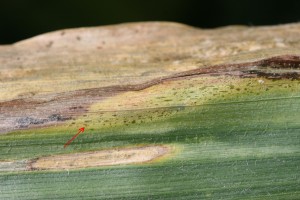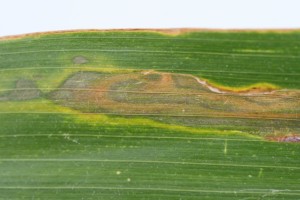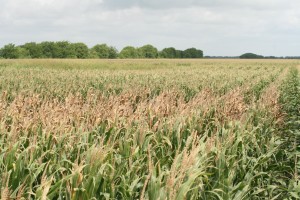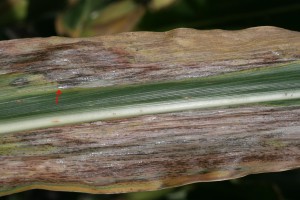by Thomas Isakeit, Professor and Extension Plant Pathologist, College Station
Goss’s wilt is a bacterial disease of corn, caused by Clavibacter michiganensis subsp. nebraskensis, which had been restricted for decades to Colorado and a few Midwestern states since its first discovery in 1969. In recent years, it appeared beyond this area, mostly in more Midwestern states, but additionally, in 2013, to the north and west, in Alberta and to the south, in Louisiana – a separation of 1900 miles and in growing areas each with very different climates than the Midwest.
In Texas, Goss’s wilt was first confirmed in Dallam county in 2009 and since then, there have been several outbreaks in other locations in the High Plains during 2014, but also, in Jackson county (possibly the southernmost occurrence in the US) in that same year. Whether these occurrences represent a “new normal” expansion of range, or are just isolated outbreaks related to unusually wet weather in combination with a susceptible hybrid and contaminated seed, will take several seasons to know.
In addition to wilt, the bacterium can cause extensive leaf blight, in which the leaves eventually become dry. The damage to fields can vary. There are impressive aerial photographs from the Midwest of completely blighted fields of susceptible hybrids, next to fields of green, resistant hybrids. In the south Texas outbreak, there were clusters of plants in the field with dead leaves (Fig. 1). These clusters of blight are usually seen when the crop is at the tassel stage. In this area, the leaves of infected, but still-living plants have “freckles” (Fig. 2) – darker spots in the lesions. This symptom is fairly common, but otherwise, leaves have water-soaked areas (Fig.3) that eventually merge and result in a general blight. As the infection proceeds, these lesions can produce an exudate of bacteria, which, when dry, has a white, scaly appearance (Fig. 4). Although the “freckles” symptom is distinctive, if it is not seen, samples will need to be submitted to a plant pathology lab for positive diagnosis, since there can be other causes for leaf blights and lesions. For seed companies or adventurous consultants, there is the additional option of an “ImmunoStrip” produced by Agdia, Inc. (www.agdia.com). This strip utilizes a lateral flow immunochromatographic assay that is actually intended to detect a related Clavibacter species that causes tomato canker, but it cross-reacts with the Goss’s wilt bacterium. The test is easy to run, takes about 5 minutes, and produces clear-cut results (Fig. 5).
Why has the disease appeared in different areas of North America lately? The pathogen is seedborne and this fits the pattern of symptom development in the field: random spots indicating a point source of a contaminated seed. The bacteria on the infected plant then spread to adjacent plants. Although bacteria can enter plants through stomata or other natural openings, higher incidences of disease are associated with injury from hail or sand blasting. In the Midwest, higher incidences of the disease were also associated with earlier planting dates. One possible explanation for this is that survival of the bacteria on residue diminishes over time, particularly at higher temperatures.
The outbreak in south Texas did not appear to have caused significant yield loss. As for the Louisiana outbreak, the yield loss within affected fields ranged from 50-100%, although the overall incidence of the disease was less than 1% in the affected areas of the state and the disease was absent from many fields of hybrids known to be susceptible to Goss’s wilt. This observation suggests an introduction from contaminated seed and additionally suggests that the pathogen is not spreading in the area.
Although there is nothing that can be done if the disease shows up in a field – fungicides are ineffective, there are steps that can be taken to prevent establishment of the pathogen. Crop residue should be buried to speed its decomposition. The field should be rotated out of corn the next season and, as a precaution, grass weeds should be controlled. The pathogen has been reported on green foxtail (Setaria viridis) and other related species, as well as barnyard grass (Echinochloa crus-galli), but observations have been made primarily on weeds that are common in the Midwest and there are insufficient observations for southern weeds. The pathogen has been reported on common wild sorghum (Sorghum bicolor ssp. arundinaceum), but apparently, it does not infect commercial sorghum or johnsongrass. As an additional control measure, many corn hybrids have resistance to the pathogen. In my opinion, this disease is not likely to become a chronic problem in Texas.
If you have any questions, contact Thomas Isakeit at (979) 862-1340 or t-isakeit@tamu.edu.

Figure 2: “Freckles” symptom of Goss’s wilt (arrow). This is a distinctive symptom for this disease. (Photo: T. Isakeit)

Figure 3: Close-up of water-soaked lesion of Goss’s wilt. This is an early symptom. (Photo: T. Isakeit)

Thomas Isakeit, Ph.D.
Professor and Extension Plant Pathologist
College Station, TX
t-isakeit@tamu.edu

